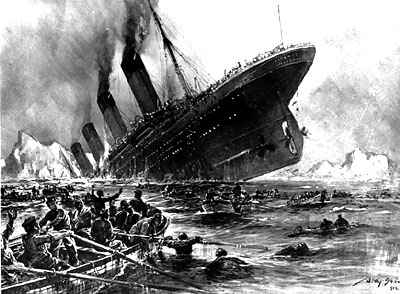

She is the R.M.S.Titanic, the luxury Liner which on her maiden voyage from England, struck an Iceberg and sank. It was the night of April 14, 1912, 1,500 lives were lost. The ship carried lifeboats for only 1,178, and many boats were launched only partly filled. Of those lost at sea, was the Capt. Edward J. Smith; a veteran of 43 years at sea, Smith had planned to retire after Titanic's maiden voyage. Titanic was not only the largest ship of her day - 882 feet 9 inches in length and 66,000 tons displacement - she was also the most expensive. One-way passage in the finest of her first-class suites cost $4,350, the equivalent of nearly $70,000 in today's funds. As the R.M.S. Titanic left the docks of London Harbor, she sounded her foghorn. On board she carried enough food to feed a small town for several months. There was on board 75,000 pounds of fresh meat, 35,000 fresh eggs, 40 tons of potatoes, 800 bundles of asparagus, 1,000 bottles of wine, 15,000 bottles of ale and stout, 12,000 dinner plates, 15,000 champagne glasses, 40,000 towels.
Unfortunately, when disaster struck, wealth sometimes made the difference between the survivors and the victims. First-class passengers were generally housed amidships nearest the lifeboats, while third class was quartered forward or aft far below. It is printed that in some cases ship's personnel prevented third-class passengers from climbing topside until most of the boats had been loaded and launched. The Titanic had all the material luxuries anyone could dream of...But one of the most important necessities the Titanic lacked cost many lives. There were not enough lifeboats, and why?

Among the survivors of Titanic was Ms. Eva Hart of England. She was seven years old at the time of the sinking, and was one of the lucky ones to be rescued in the lifeboats. Her father was lost but she rode to safety with her mother. Ms. Hart, recalls that her mother refused to go to bed aboard Titanic, Hart is quoted as saying, "because she had this premonition, solely based on the fact that she said to declare a vessel "unsinkable" was flying in the face of God." Of Titanic's final moments she says simply: "I saw that ship sink. I saw all the horror of its sinking. And I heard, even more dreadful, the cries of drowning people." As the Titanic slipped down into the icy cold Atlantic, the Titanic Band kept playing until the ship sank.
Ms. Hart was like most Titanic survivors, she believed Titanic should be left intact as a memorial to those who went down with her.

The Ghostly hulk of R.M.S. Titanic lies in her lonely berth more than two miles deep in the North Atlantic, her bow festooned by decades of rust and sediment. Railings curve around a grate forward of the 18-ton auxiliary anchor of the largest, most luxurious ocean liner of her day.
For over eighty years, while the grand and tragic ship was celebrated in legend, the wreckage sat in abject darkness, until her discovery September 1, 1985, by Dr. Robert Ballard of the Woods Hole Oceanographic Institution in Massachusetts. And a joint U.S. - French expedition.
But it was from the Crow's nest that the real story took place. For it was from this station that lookout Fred Fleet, who survived, first sighted the iceberg one-forth of a mile dead ahead. Instinctively he gave three rings on the bell above the crow's nest. And over the ship's telephone system Fleet warned the bridge, "Iceberg right ahead!"
Ironically, Fleet's words doomed Titanic. In response to the warning her officer-in-charge tried to reverse engines and turn hard to starboard. The reversal actually turned the ship slowly to port, and she suffered the fatal gash in her starboard side. Had she rammed the berg head-on, it is said, she would likely have flooded only two or three compartments and remained afloat. But this is only one theory there are many through the years.
The
tragedy of the Titanic caused many new regulations to arise. All ships were required to carry enough life boats for all the passengers and crew. A universal distress call "SOS" was adopted because it would be easy to recognize and send out. All ships were required to have 24 hour radio watch. ( This photo of the bow railing) is one of the most "recognizable" and moving images of the great Titanic. Questions will always be unanswered...Why were there too few lifeboats, Why was there a nearby ship that never came to the aid of the Titanic. And then there were the icebergs...All that could have been...and was not to be.


[Home]
[Norman Rockwell Museum]
[Rockwell Self Portrait]
[Sturbridge Village]
[Sturbridge Colonial Farming]
[Dickinson Homestead]
[Dickinson Portrait]
[Springfield Armory]
[Stanley Park]
[The Titanic Historical Museum]
[Maude Tait]
[Connecticut Trolley Museum]
[Dr. Seuss]
[New England Links]